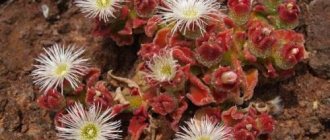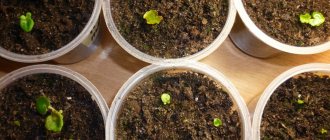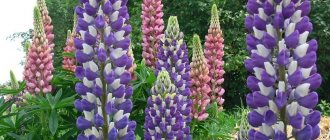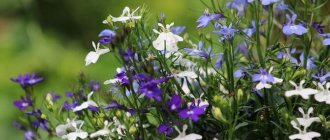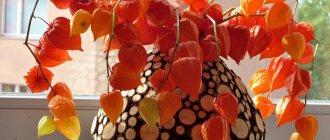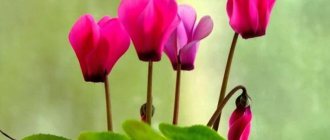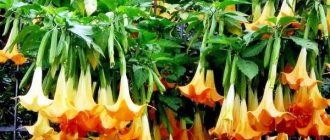Flax is a popular plant that is grown on a large scale for textiles, flour and oil production, and other uses. In addition, flax can be used as an ornamental plant to decorate a garden plot. In most cases, flax seeds are immediately planted in open ground, because the plant has a sensitive and fragile root system, and it germinates easily. However, if you live in cold regions (Siberia, the Urals, Leningrad region, Moscow region) and want to see flowering earlier, you can first grow decorative flax seedlings, and then carefully plant them in a permanent place.
Description of perennial blue flax
Flax, as a plant belonging to the herbaceous species, has approximately 200 different varieties in its arsenal. If we talk about how it looks, it is a small plant. Its thin stems usually grow 50 cm tall, but they are quite resilient.
The color of the plant is different. Its flowers can be painted in pale blue, white and pink-red. Flowering also looks different; it can be small or large. Feels better in areas with moderate climatic conditions.
Almost half of its seeds consist of various oils. These include linolenic oil, linoleic oil, oleic oil, palmitic oil and stearic oil. It is also useful for its organic acids, enzymes and vitamins A, proteins and carbohydrates. They are actively used to treat inflammatory processes inside the body and against pain. Pharmacists actively recommend its use to maintain health in case of cardiovascular problems.
Photo of flax
In addition to its benefits for internal treatment of the body, it is widely used to heal burns and radiation injuries of the body. Even in the fight against breast cancer, it is striking in its high rates of inhibiting the development of such a problem. When a person decides to lose weight, this miraculous flower also comes to the rescue, as it perfectly removes toxins and waste. In the field of beauty, to improve the appearance of skin, hair, nails, and for an easier period of menopause, this flower is used extensively.
Below is a description of a plant such as flax.
Cultivation technology
Flax is a valuable agricultural crop, especially the oilseed subspecies (curly, mezheumok), widely used in production. It is a source of vegetable protein, which is used in animal husbandry, as well as technical oil, as a raw material in various types of industry (paint and varnish, leather and footwear, soap making, etc.).
Nowadays, eating seeds that have medicinal properties has become especially popular. They contain a large amount of linolenic acid. If you regularly take flaxseed oil, it will remove cholesterol from the body, improve metabolic processes and normalize blood pressure. Taking it reduces the risk of blood clots and cancer, as well as cardiovascular and allergic diseases.
After obtaining flaxseed oil under production conditions, what remains is meal (cake), which is a concentrated valuable feed. It is used in animal husbandry. When combined with water, it increases in volume, forming mucus, becoming a valuable dietary product.
Flaxseed itself in its entirety is used by different peoples as an additive to bread and cereal mixtures. Possessing gelatinizing properties, it has found application in cooking.
Freshly prepared infusion of seeds poured with boiling water is used in the treatment of gastritis, enterocolitis, dyspepsia and burns.
The flax stem contains up to 18% fiber, so it is used in the production of coarse fabrics, as well as thermal insulation and packaging materials. Flax flax is used by pressing for the production of building boards.
Types and varieties of flax
Here is a brief description of just a few varieties:
- Large-flowered flax is considered one of the most popular varieties. As a rule, it grows in height no higher than 0.5 meters. It has large flowers of various colors. Recognized as a perennial plant. It is believed that if all the rules for planting and care are followed, it can not be transplanted to another place for five years.
- Red flax - blooms all summer. Annual plant. Elongated leaves are located on half-meter stems. The width of the flowers is 4 cm. The life of one flower is one day. When evening comes, it falls. But the next morning others appear. Outwardly they look a little like poppies. When this plant is planted in a group, it looks
Red linen - Decorative flax is a very unpretentious plant. This means that a person who has not gardened before can, if desired, grow one without any problems. Interestingly, fabrics for sewing are made from certain types of this variety.
- Yellow flax - a 40-centimeter lush shrub that lives for many years, producing yellow flowers. It prefers dry soil with a high limestone content. June and July are the time when you can admire yellow flowers.
- Alpine flax - lanceolate-shaped leaves. Inflorescences of a simple type contain flowers of pale blue colors. It spreads like a 20-centimeter-high carpet. It is often placed near the border and in flower beds, combined with stone details.
Briefly about the main thing
Perennial decorative flax is a beautiful plant that can decorate a flower bed in front of the house, a prefabricated flower garden, a mixborder and even a rock garden. It is unpretentious, but can please with its beauty and melt someone’s soul. It is easy to care for. With the right approach, it is not difficult to grow lush grass on your site, which has a special decorative effect.
Planting flax in open ground
As mentioned above, blue flax does not require special conditions when growing. This makes it much easier to find a suitable place for it to live. However, for more successful development, the flower must germinate in a place where there is enough sunlight and no shadow from other plants and buildings. But not every area has a lot of sun. If this is the case for you, then the likelihood of growing a perennial plant is reduced to scanty levels.
The flower, among other things, is unpretentious to the type of soil. Any soil other than marshy soil will be suitable for it . Let the soil itself be light, and the groundwater should flow deeper. Slopes that are not very steep are perfect for such a flower.
Flax field
It is recommended to plant the seeds of this plant inside pots at home. If we talk about when to plant flax in open ground directly from seeds, then this work is allowed to be done only in those areas where the climatic conditions are mild and warm. You should not plant them very deep, but simply distribute them on the ground and moisten the surface of the soil with a spray bottle. This can also be done in the spring, when during the day the air temperature will be about 20 degrees above zero. In the fall - before the readings drop below 20 degrees.
When sowing a perennial plant of this type in open ground, it is important to remember the cold period. When it is raining and damp, such procedures are prohibited. Those places where the crops are placed are covered with a layer of earth and protected in the same way as other flowers. For successful cultivation, you must follow the rules for planting and caring for flax.
Germination of seeds
Flax is a grain that is eaten sprouted. It is a source of health, rich in amino acids and microelements, vitamins. With its help they cope with many diseases. How to germinate flax at home? To do this, you will need a regular tray or plate, as well as gauze and a sieve.
The seeds are poured onto a tray and covered with a millimeter of water. After 8-10 hours, they are washed from mucus using a sieve. Then wet gauze is spread on the tray. Seeds are placed on it. They are kept in a well-lit place, but without direct sunlight. Periodically moisten the gauze and make sure it does not dry out. When after a few days the sprouts appear up to two centimeters, they are eaten. The finished product can be stored in the refrigerator for about five days. Then you need to germinate a new batch.
People who consume sprouted seeds experience improved skin condition. It becomes elastic and resilient. Various dermatitis, eczema and even psoriasis will bother you less. In addition, nails become stronger, and hair becomes thick and shiny. The gastrointestinal tract improves its functioning, hence the gentle weight loss for those who have excess weight.
Flax propagation
Gardeners usually use one of the following methods of flax propagation:
Generative seed method
To do this, you can use containers or directly plant the seeds in open ground. It is best to do this in the spring or fall before the onset of winter conditions in the manner described above. This procedure is also allowed in the summer.
flax bush
If you use the method with containers, then replanting the sprouts in open ground will not work, since they most often die. Containers become their permanent habitat. After planting, they will need to be moved to fresh air.
Dividing the bush
This method is suitable for biennial plants. Separation of some parts from the main bush should be done in April or, when the flowering season has passed - this is August. This process involves placing the seedlings 0.2 meters apart from each other. It is important to water them regularly and protect them from direct exposure to the sun.
Caring for blue flax
In order to admire delicate flowers in the summer, even if not for as long as other representatives of the flora, you should consider and follow certain care rules. Below is a summary of what they include.
The flax plant is in dire need of periodic watering, but it is important not to cross the line that will prevent the ground from turning into a swampy place . It does not tolerate stagnant fluid. Watering is allowed no more than twice a week. The frequency depends on the air temperature and humidity. But after the end of the summer period it needs to be reduced and eventually stopped completely.
Flax
Another point in care is weeding, which must be done at regular intervals. Weeds and too dense vegetation have a bad effect on the external condition of the flower. In addition, due to this problem, the plant can be more quickly attacked by pests. They are easily carried by weeds.
There is often no need to fertilize the plant. However, this must be done at certain periods. Before planting seeds in open ground, the soil is minimally fed with organic matter and very little potassium fertilizer.
During growth, it also needs to be fertilized once or twice, using liquid formulations for this. It is recommended to perform such actions only after watering.
Flax behaves quite calmly in relation to diseases and pests. It is rare, but it happens that a plant can be affected by flax flea beetle. In the fight against it, folk methods bring little effect. In order not to waste precious time, it is better to immediately treat those shrubs that have been infected with chemicals.
To achieve successful growth and flowering of flax on your estate, it is recommended to place it together with plants of a similar development pattern and with those who need the same living conditions. This article mentioned all the basic conditions for how to grow flax in the country.
Diseases
Flax has excellent immunity and is highly resistant to pests. However, the flea likes to settle on it. It looks like a black or dark green bug with a 2 mm body. The pest loves to eat the contents of the seed pods, and when it runs out, it eats the stems and leaves. The flea beetle gets onto flax through weeds; one colony can completely destroy an adult bush in just a couple of months.
Flax thrips are another common pest that you should be wary of. It sucks the juice out of the plant, after which the leaves wither, the flowers fall off prematurely, and the grass simply stops growing.
Flax thrips pestSource industry.nzavocado.co.nz
As practice shows, fighting such insects with folk remedies is ineffective. Therefore, you immediately need to treat the bush with chemicals (insecticides).
Linen in landscape design
Perennial flax is used by gardeners quite often. It is recommended to plant it in various compositions. For example, mixborders, rock gardens, borders and flower beds will look great if it was decided to plant flax in their composition.
In order for this representative of the flora to feel good in the garden and decorate it with dignity, you need to be able to correctly combine it with other plants. They should also love the lack of direct exposure to the sun and the long absence of moisture. They learned how to properly plant this flower in a Moorish lawn. It is recommended to group it with marigolds, daisies, clover and cornflowers. It will fit well against the backdrop of a natural and rustic design style.
The plant looks quite impressive near those that have textured dark-colored foliage. To organize an alpine hill, it is planted together with cloves, bellflowers and even cereals. Such rich representatives of flora as roses and lilies look very beautiful next to such a simple flower. This makes linen completely unattractive. Therefore, it is better to avoid such compositions.
Diseases
Flax has excellent immunity and is highly resistant to pests. However, the flea likes to settle on it. It looks like a black or dark green bug with a 2 mm body. The pest loves to eat the contents of the seed pods, and when it runs out, it eats the stems and leaves. The flea beetle gets onto flax through weeds; one colony can completely destroy an adult bush in just a couple of months.
Flax thrips are another common pest that you should be wary of. It sucks the juice out of the plant, after which the leaves wither, the flowers fall off prematurely, and the grass simply stops growing.
Flax thrips pestSource industry.nzavocado.co.nz
As practice shows, fighting such insects with folk remedies is ineffective. Therefore, you immediately need to treat the bush with chemicals (insecticides).
